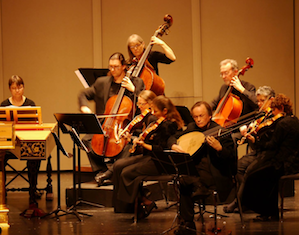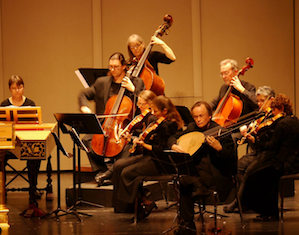
Philharmonia Baroque Orchestra's latest series of concerts, somewhat nonspecifically named “Music From the Heart of Europe,” was loosely centered on a selection of country-and-nation-themed dance suites and orchestral sonatas from the Baroque era. It was performed by a core ensemble of strings and continuo, with Elizabeth Blumenstock as leader and violin soloist.
Given the number of lesser-known composers on the program, the 17th and 18th centuries must be a near-endless source of some of the most beautiful music known to humankind — and the concert demonstrated exactly that.
Among works from the “famous and familiar,” such as J.S. Bach, Georg Philipp Telemann, and Georg Muffat, there was the delightful Suite VII by Johann Schein (who was incidentally one of Bach’s predecessors as Thomaskantor in Leipzig), an orchestral sonata and a ballet suite by Johann Heinrich Schmelzer (ca. 1620–1680), plus a charming violin concerto by German composer Joseph Umstatt (1711–1762).
In spite of the unfailing appeal of the timeless music on the program and the high-spirited and exemplary execution that we have come to expect and appreciate from PBO, the concert left me with a slight and rather irrational bit of frustration when I realized that we, as a modern audience, will never be able to really hear Baroque music for the first time.
The 17th and 18th centuries must be a near-endless source of some of the most beautiful music known to humankind — and the concert demonstrated exactly that.
No matter how authentic, how historically and stylistically correct, and how convincing a performance may be, we listeners could only hear Baroque music as something truly new if we could temporarily erase every post-Baroque musical reference from our minds and hear the music with no interference from Mozart, Beethoven, Stravinsky, jazz, and even rock ’n’ roll (to cite only a few examples).
Still, Philharmonia Baroque gets you just about as close as possible.
One of the gems on PBO’s program was the lovely Sonata for Orchestra in C Minor by Johann Georg Pisendel (1687–1755), who left only a handful of works but was in fact the foremost German violinist of his day and influential enough to have Vivaldi, Albinoni, and Telemann all dedicate violin concertos to him.
Like the concert itself, Blumenstock’s playing was breezy and elegant, and she made the central Adagio sound like a sweet little love song.
Another pleasant surprise on display were the two works by Johann Schmelzer, with the ever-moving melodies in the Sonata III from Sacro-profanum Concentus Musicus, and its obvious dance origins made abundantly clear in the hoedown effects and excited rhythms of the Balletto a 4 Pastorella. The piece consists of a series of gavottes, each depicting a different European nationality: German, English, French, but also Bavarian and Styrian (from Steiermark, now part of Austria).
As a soloist, the redoubtable Elizabeth Blumenstock played Umstatt’s Concerto for Violin, Strings, and Continuo in A Major, which she considers to be “the world’s tiniest violin concerto.” Like the concert itself, Blumenstock’s playing was breezy and elegant, and she made the central Adagio sound like a sweet little love song.
The Overture-Suite in B-flat Major Les Nations by Telemann (1681–1767), with which the concert concluded, is yet another piece about nations and nationalities — the Turks, the Swiss, the Muscovites, and the Portuguese — as well as two related rarities in the form of vivid musical descriptions of travel by donkey-cart and by horseback. It showed the members of PBO in some of the finest ensemble playing imaginable.

